THE
Fencing Masters Program: my
fast Learning Experience
|
While the page http://home.uchicago.edu/~advorak/CaliforniaNew.html describes how my stay in the Fencing Masters Program (FMP) came to be at all, below is the story of the two examinations I took during my studies in the program. In the FMP, there are 3 levels of certification. The first one is for Instructors at Arms, who are certified to teach one of the Classical Fencing weapons--the foil. Then, there are the higher degrees of Provost and Master at Arms. The Master is the final degree, after which one is ready to open his/her own fencing school. Provosts at Arms are tested in teaching all the three Classical Fencing weapons--the foil, sabre, and epee. My FMP stay was a fast learning experience in many ways, most importantly in that I had about 10 weeks to learn everything that an Instructor at Arms needs to know, and be able to execute. It is an unusual story of how this idea originated, as preparing oneself for the first examination (for the Instructor at Arms one) normally takes at least a year of work, and that for people with previous Classical Fencing experience, which I had none. And my examination for the second degree, the one of Provost at Arms, followed soon as well. I passed the second examination in less than one year and a half from the first ever time I held a foil, or any of the other Classical Fencing weapons for that matter. And since I took half a year break during this period, it effectively left me with only a single year of actual studies remaining. During this time, I obviously received a lot of extra, dedicated help provided by both people from within the FMP itself, and from others, in particular from Maestri Curtis and Myers (pictured below in black), together with Provost Murakoshi, who all actually brought me to the FMP to begin with, and who helped me a lot before my first examination.
Within the FMP, my principal teachers and classmates were (back row from left to right:) Brian DeRaad, Provost Brian Bacher, Provost Tony Barajas, Instructor Sydney Thomson, Maestro Gary Murry, Maestro Ralph Sahm, Maestra Janine Sahm, Provost Jeremy Tavan, Maestro Dan West, Wendy Phillips, Behzad Sanii, Provost David Cogley, (and in the front row from left to right:) Instructor Dori Coblentz, Mako Suzuki, (next is currently already Provost Antonie Dvorakova), Steven Flaugher, Maestro David Coblentz, and Maestro Daniel Williams. Then Master Candidate David Coblentz and his wife, Instructor Dori Coblentz, provided a lot of support especially before my second examination, beginning with finding housing for me in the area.
However, this whole story serves as a tribute to Maestro Sahm, who prior to my second examination exhibited yet another, superior level of truly outstanding teaching excellence and integrity, going way beyond and above of anything that could have been reasonably expected. To narrate all the details would make for an unduly long story, thus it will suffice to illustrate the situation by saying that Maestro Sahm came to help me, as well as the Master at Arms Candidate David Coblentz, also at venues other than the FMP, beginning with the weeknights SCAE classes (1st row of pictures below). Additional alternative venues included the San Mateo fencing school of Maestro Scherman, where we all also helped with teaching (2nd row of pictures), my fitness club where I arranged for fencing floor (3rd row), Provost Tavan's backyard (4th row), and when we were not able to practice our group lessons elsewhere, Maestro Sahm helped us even with that at the house of Instructor Thompson and Provost Barahas (last row of pictures below).
In addition to helping with my teaching, Maestro Sahm has been giving me private lessons 2-3 times a week, and he even "actually fenced" with me in order to provide me with the pertinent experience. In the second picture, he is doing so in my fitness club actually even on the day of Christmas Eve!
|

antonieHow (How To Do Just About Everything Unimaginable)
How to become A FMP instructor at arms in less than 3 months Note: The Fencing Masters Program (http://www.fencingmastersprogram.com/about.php) offers formal training and accredited certification for fencing teachers. Its pedagogy is based on the classical Italian system used by the Scuola Magistrale Militare di Roma.
|
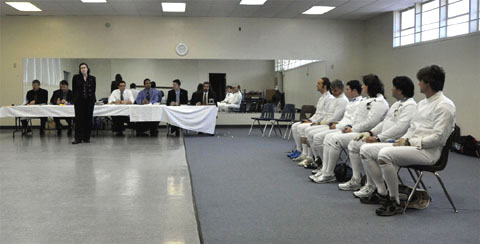
On March 27th, 2010 seven Maestri gathered to examine a single Instructor at Arms candidate, and six provosts/instructors/students were ready to take lessons from her.
The examiners were Maestro Sahm, Maestro Murry, Maestra Sahm, Maestro Williams, Maestro West, Maestro Hasenkamp, and Maestro Curtis (Maestro Myers unfortunately fell ill in the last minute, thus he was unable to attend).
The first part of the examination was an oral test in classical Italian foil theory. The Maestri run out of questions before finding one that would not be correctly answered :-). The written test administered exactly a month earlier went very similarly.
The practical exam was where the real challenge was to be found, however. The second part of the exam consisted of group lesson administration.
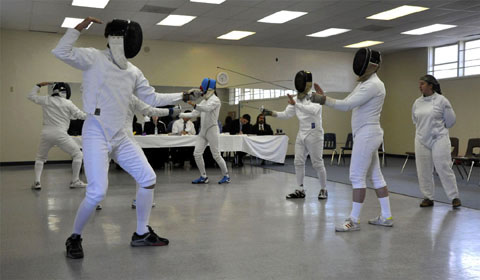
The group lesson participants were Provosts at Arms Tavan, Bacher, Cogley, and Barajas, together with Instructors at Arms Thomson, plus Martin Tali.
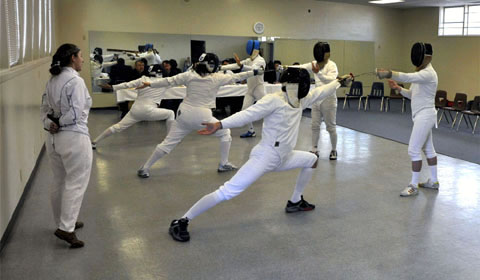
The examination begun at 9:00 a.m., and said Instructor at Arms candidate took seriously her responsibility for entertaining everyone throughout the almost three hours of the allotted examination time.
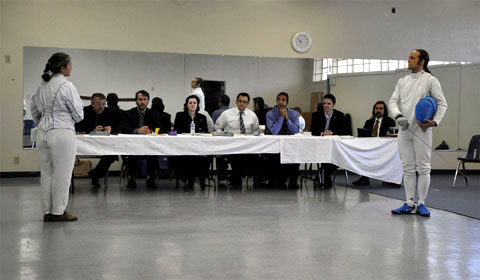
Provost Jeremy Tavan has very personal experience with this...
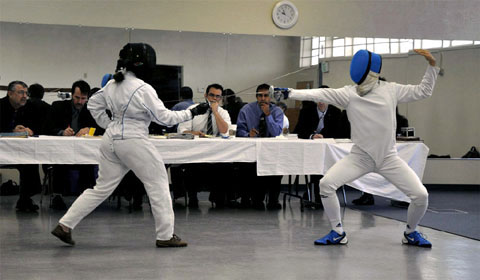
…pictured during the 3rd part of the exam = giving an individual lesson.
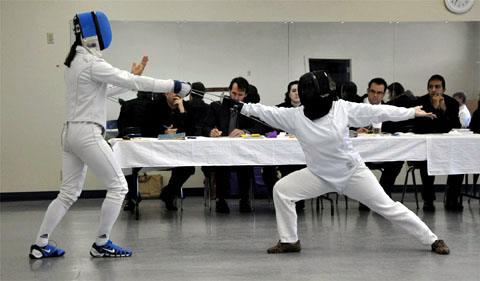
When I grow up, I want to be like Jeremy—that is at least in one regard. After I took the same lesson (in fact a somewhat shorter one) from Jeremy, which was the fourth part of the exam, I was “ready to die” :-). Why would this be, when I am known to be typically the "last (wo)man standing" and asking for more work even at multi-day intensive fencing seminars? The "problem" was that while teaching me, Jeremy went for the desired FMP speed and intensity, thus he "forgot" to intersperse the standing around/talking time, which is such an integral part of workshops organized within the U.S. western martial arts community :-).
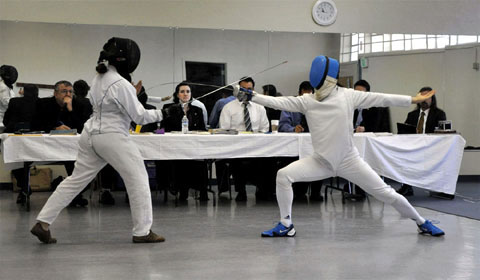
The fifth part were “random actions,” meaning that each Maestro could ask for any action, or actions combination, from the whole FMP foil curriculum. However, not much surprise was left to me after Maestro Sahm had been entertaining himself by giving me sequences like: "straight thrust, double counter of 3rd, change of engagement to 4th, flanconade in 4th, and 2nd intention indirect," and that in time and at once, the week before the exam. In any case, Provosts Bacher and Cogley were nudging each other and commenting quietly that the given tasks were way above the usual tasks for Instructor at Arms candidates.
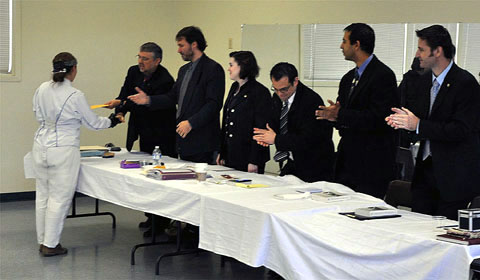
And the result? Some might wonder, as this exam transpired less than 3 months after I entered the FMP, and about 4 months after the first ever time I picked up a foil. Similarly, my written exam took place in less than 2 months into my FMP studies. Well, my practical exam score was just somewhat above the average, and my written test score way above the average (I missed less than 5% of the possible points). Additionally, I consider my willingness to take the exam--although my score was not going to be perfect--a victory over my perfectionism (as I have not gotten a grade other than an A in the 10 years of my university studies).
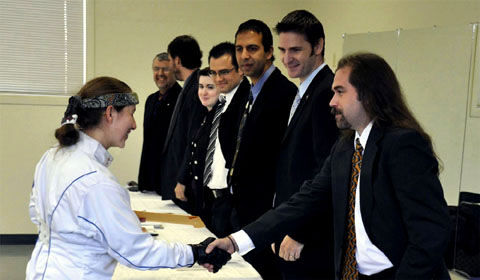
After the award of my FMP Instructor at Arms certificate, congratulations followed. And how was this all possible? I, as a student, have "met my match” in the Sahms as teachers. They are happy to teach any student as hard as he/she is willing/able to learn. I practiced with them 4 times a week throughout my stay, and no-one "good, and at the same time willing enough" within the perimeter of 150 miles was “safe from helping” :-) during the other days. Thus, together with most importantly Maestro and Maestra Sahm, with their teaching excellence, the congratulations belonged to everyone involved.
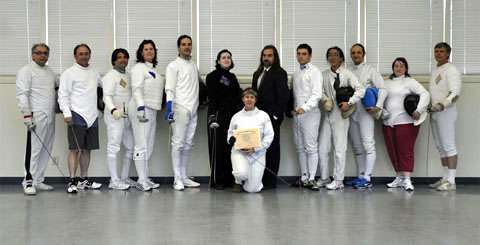
Since I am the “let us *do* something” student, it is only appropriate that I failed to take a picture of me just posing with everyone after the exam. Instead, I have a picture of Antonie Dvorakova in her first FMP class in the capacity of a FMP certified Instructor at Arms.
And how appropriate that in the middle appear the two most important “culprits.” Although many people were involved, it is mostly the “fault” of Maestro Curtis that I ever seriously considered the FMP to begin with. Maestra Sahm, then, has the “lion share” of the “fault” for the fact that I took my examination at this time, and thus—in the words of Maestro Curtis—“broke the world record in time-to-examination ratio.”
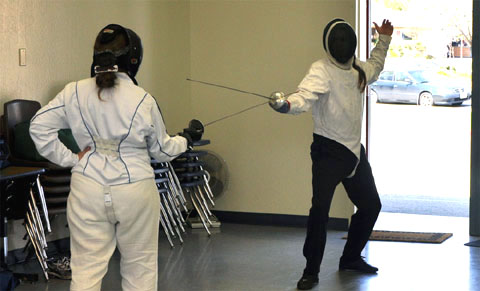
But since there is never a shortage of challenges in the FMP, Maestra Sahm first assigned their greenest Instructor at Arms to teach their newest student. This was Scott Aldinger, who, after his 2 visits to the FMP was still at that time asserting he was “*not* joining the program.” (Not only Scott but also his girlfriend Arielle joined the FMP when I came back there, however). In any case, now came handy the fact that when “the Northern Maestri” were working with me, they emphasized making sure I was ready not only for my exam, but also for “real life.”
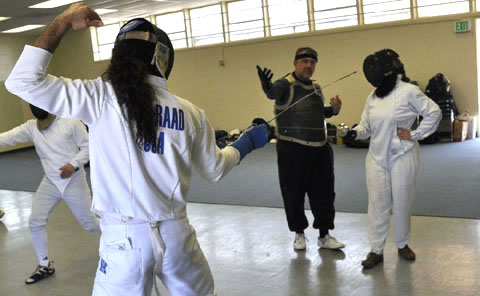
Next, in contrast with "the newest guy," Maestro Sahm had me teach Brian DeRaad (with whom he normally "deals" himself). Brian is a serious competitive fencer, and I do not even want to guess how tall he is. Suffices to say he is, by far, the tallest man around. Additionally, Brian embodies especially well the first three pre-requisites of an efficient lunge, which are speed, violence, and length. Using the allegory concerning another fencer, if he hits like a ton of bricks, Brian hits like a very angry ton of bricks, which was supposed to be a few meters away before you blinked. In other words, as Brian's opponent, one could not afford blinking (although not that it would help her much anyway).
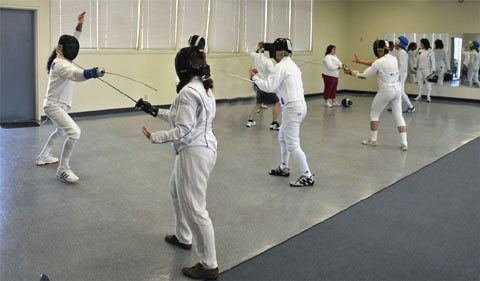
How convenient, then, is being Brian’s instructor instead! As such, one can afford to leisurely blink first (although one does not get much longer in order not to hold the lesson :-), and move only next, thus only then triggering Brian. In any case, now came handy what Maestro Sahm told me--that had they wished that I become "only" an Instructor as Arms, there was no need for him to volunteer to give me private lessons, like he had indeed been doing throughout my whole stay 2-3 times a week. Both Maestri Sahm also said they would not even need to teach me as hard as they did, had it not been their policy to treat each student as a master candidate. Concerning Brian, then, Maestro Sahm even did a couple of “show and tell” with him for me on previous occasions.
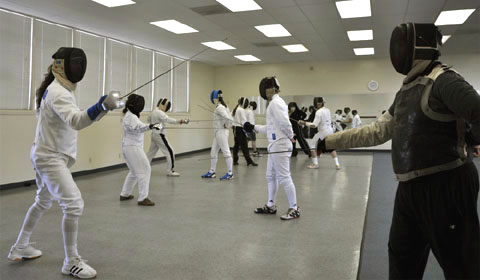
When the foil lessons were over, thus epee and sabre lessons commenced, the Maestri were ascertaining whom they had to teach (as opposed to take) the lessons. Since there appeared to be a shortage of teachers, Brian (Provost Bacher) volunteered: “What about Antonie, her Provost at Arms exam is next, thus she should begin teaching the other weapons as well!” “Hold your horses!” replied I, however, while happily turning Brian DuRaad back to Maestro Sahm, and becoming a student of the future Maestro to be examined in Naples :-), D. Cogley.
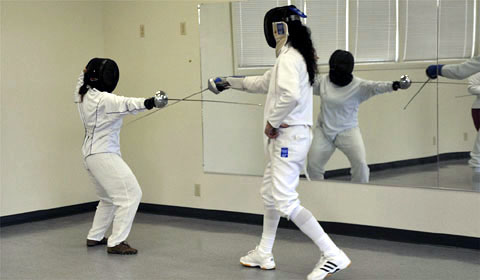
Speaking of which, remember how people use the trick where they say, or do, something to predict a future step, which I at that time refuse to even imagine? I was going to keep the following secret, but now that it is out what Maestro Gaugler inscribed (with a nifty smile) into my copy of "The Book" (his Science of Fencing), together with what he wrote to me at the eve of my Instructor at Arms examination, I give up. In fact, my protests against the switching of the above picture, meaning being put on the epee teaching side, did not hold for that long either...
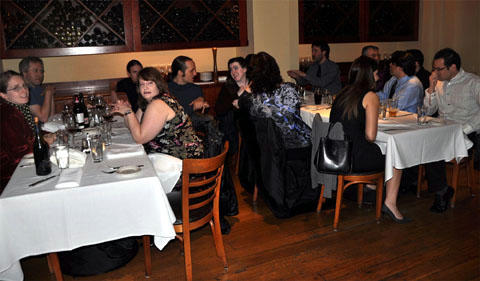
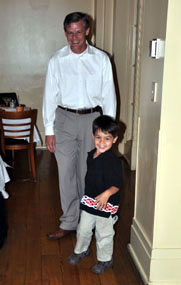
Finally, above are three photos from our exam celebration dinner, which took place, as per the FMP tradition, in the Il Fornaio restaurant in San Jose. Brian (Provost Bacher) brought his whole family. If you ever get to meet his girl, ask her for the story of how her daddy taught her to ride a bike, as this story greatly facilitates the understanding of many aspects of Brian's teaching style. And, as per usual, David (Provost Cogley) was "killing" everyone by telling his jokes. In the left picture directly above, note even my brother Marian, who otherwise lives in the Czech Republic (although he took all the above-displayed photos of my examination). Scott Aldinger, who was then still “not joining” the FMP, was present as well. When we were parting, and I was to drive back to Chicago the next day, Maestro Williams inquired when I would be back for my Provost at Arms examination. I acted as if I did not know what he was talking about (in fact, I was completely sincere in this regard at this time), but...
the Provost at ARMS examination On May 7th, 2011, a commission of maestri from the SJSU Fencing Masters Certificate Program held the Provost at Arms examination of Antonie Dvořáková, and the Master at Arms examination of David Coblentz. |
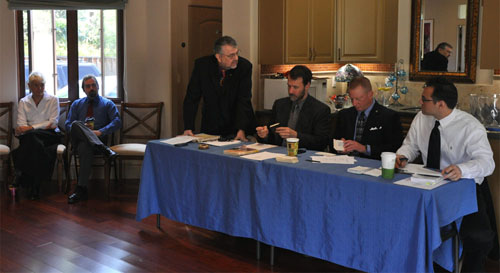
This first photo shows the board--Maestri Ralph Sahm, Gary Murry, Paul Scherman, and Daniel Williams, together with other maestri in attendance--Maestri Margaret Dickerson and Puck Curtis, setting up.
Here we have Provosts and Instructors at Arms from the FMP, ready to entertain not only the maestri, but also other guests, including Richard Lowry (back row on the right) from the Sonoma State University FMCP.
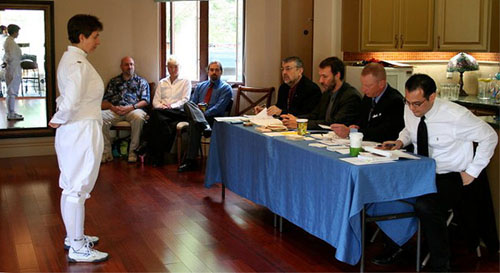
The first part of the examination concerned theory. (And yes, in epee, the valid target does include the bottom of the foot! :-)
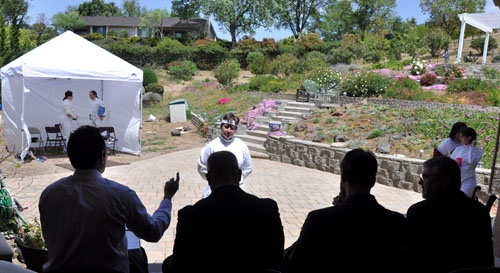
The beautiful backdrop for the group lessons was provided by the gardens belonging to the San Jose villa of Sydney Thompson and Anthony Barahas.
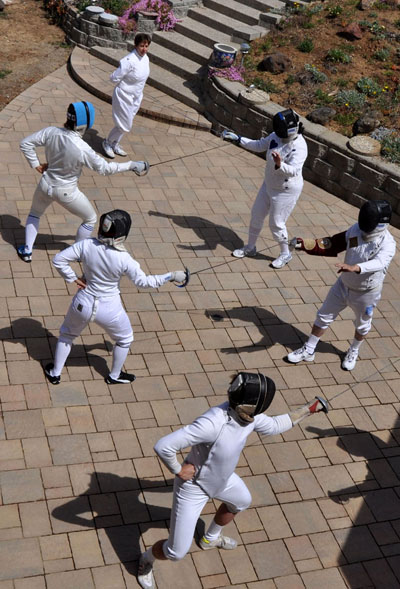
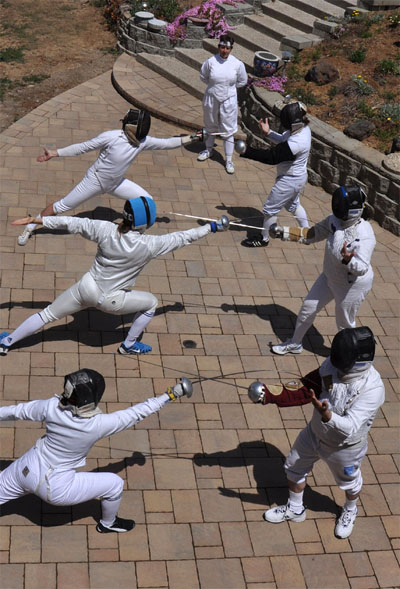
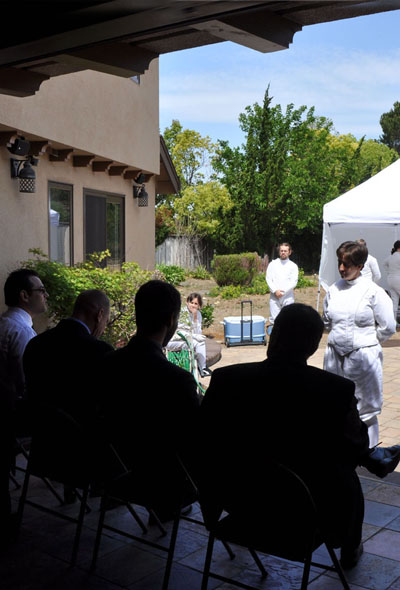
Sabre and epee group lessons followed, with feedback being provided after each of them.
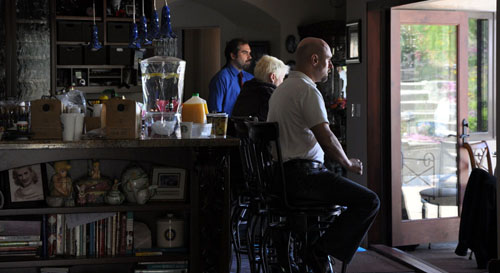
The maestri and audience enjoyed the shade throughout the event, and everyone partook in abundant refreshments, beginning with breakfast involving a variety of pastries, in addition to the obligatory bacon and eggs.
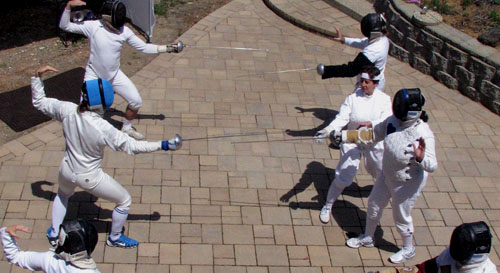
For lunch, the prosciutto, together with a variety of Italian salami and cheeses came out. One guest called the event a "Dolce Vita" experience. But back to the business of giving commands and making corrections...
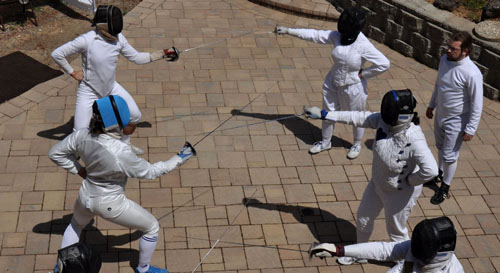
During the group lessons commanded by Candidate Coblentz, I "won" :-) for my student our *left-handed* Provost "The Freight Train" Bacher :-).
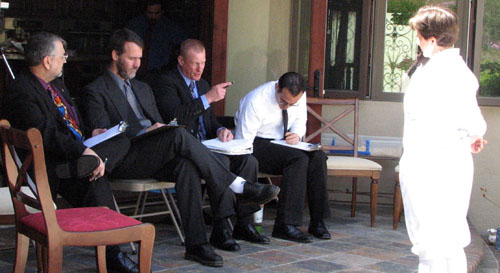
And apparently got myself in trouble... :-).
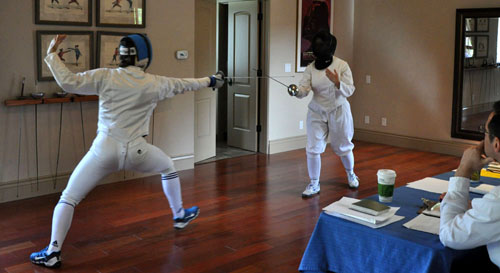
My teaching of individual lessons followed in THE fencing room.
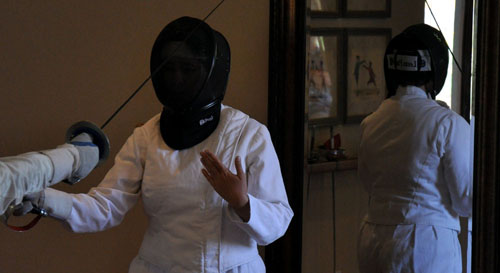
My performance was watched very closely, apparently from all sides :-).
As a Provost at Arms candidate, I tested in all the three Italian Classical Fencing weapons--foil, sabre, and epee. I always had to go first, while the Master Candidate David Coblentz gave the same lessons afterwards.
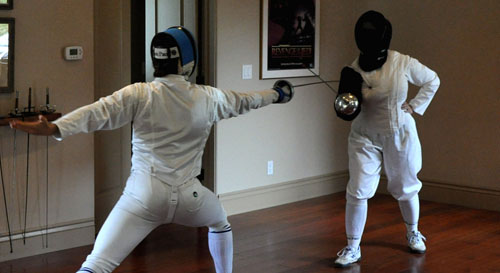
The last part of the examination again involved "actions at random," which means that each of the maestri can ask the candidate to teach her student any combination of any actions in all the 3 weapons, foil, sabre, and epee.
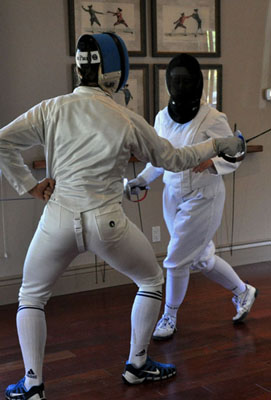
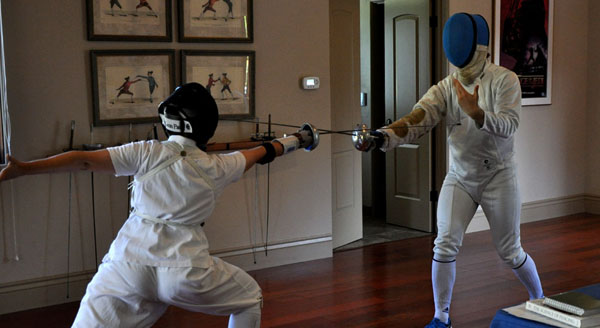
In all the individual lessons and "actions at random," my student was again the trusted Provost Jeremy Tavan, with whom I previously passed my Fencing Masters Program Instructor at Arms examination as well. Jeremy also assisted me during the examination lessons, in which I was in the role of a student.
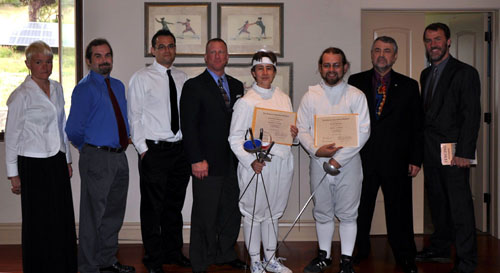
Here we have already Provost at Arms Antonie Dvořáková and Master at Arms David Coblentz, with all the present maestri. Like during my FMP Instructor at Arms examination, which took place in less than 3 months from the beginning of my FMP studies, I not only passed, but in fact did pretty well also in this examination. Of course, none of this would have happened without a lot of dedicated help from a number of people from the Fencing Masters Program, and especially Maestro Sahm, who displayed yet another level of going above and beyond the call of teaching excellence.
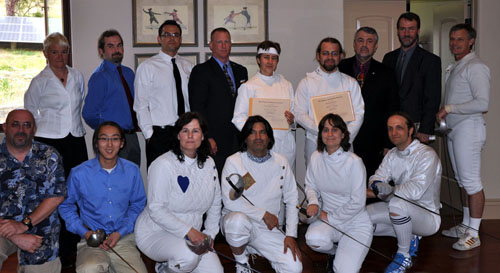
The new provost and all the maestri joined by other involved fencers, and some of our guests. Back row from right to left: Provost Brian Bacher, Maestro Gary Murry, Maestro Ralph Sahm, Maestro David Coblentz, Provost Antonie Dvořáková, Maestro Paul Scherman, Maestro Daniel Williams, Maestro Puck Curtis, Maestra Margaret Dickerson; front row from left to right: Maestra Dickerson's fiancee Jeff, Provost Kevin Murakoshi, Instructor Sydney Thompson, Provost Anthony Barajas, Instructor Dori Coblentz, and Provost Jeremy Tavan.)
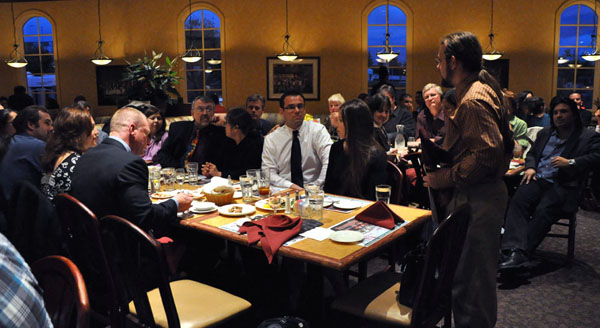
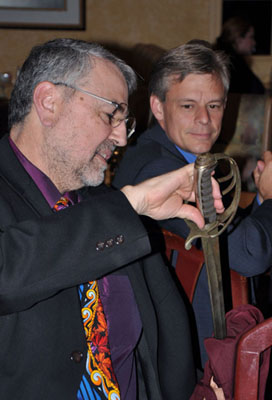
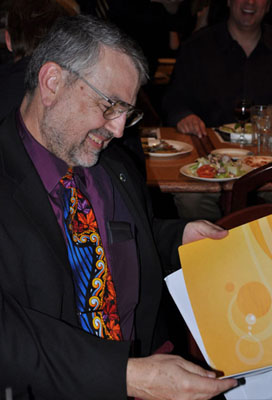
During the subsequent celebration dinner, the new Maestro Coblentz presented a special gift. Maestro Sahm was at first trying to appear like it might not even concern him. But since no other maestro/a was found in the room, who would be eligible to even think of celebrating a quarter of century since he/she acquired his/her title, Maestro Sahm was ultimately the one to receive his 19th century Italian cavalry sabre. It seems that he enjoyed his card as well :-).
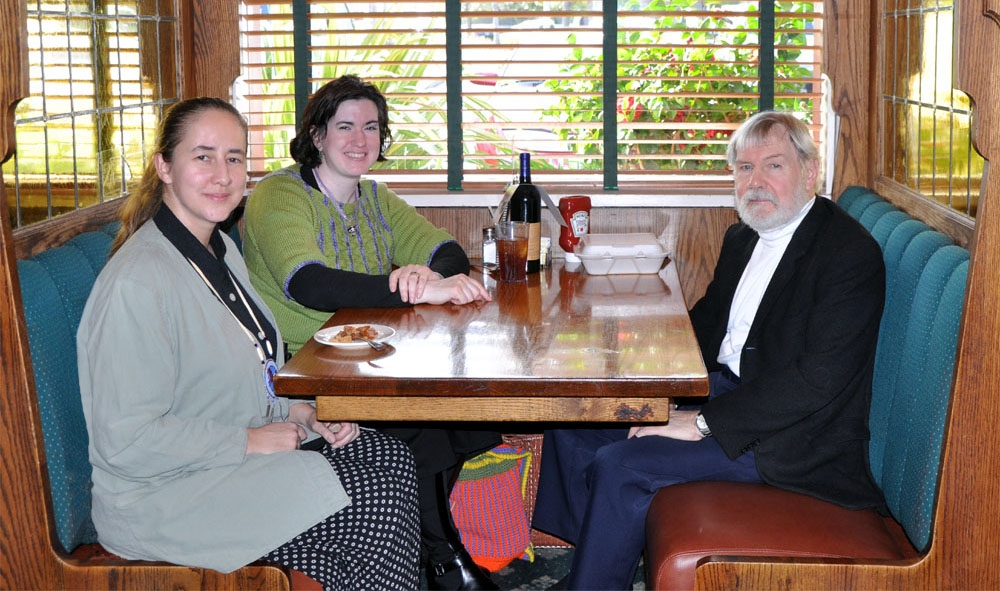
While Maestro William Gaugler, the founder of the Fencing Masters Program, whom I met during my first stay, was not able to be a part of my exams, he wrote to me with his congratulations and encouragement for the future after both my Instructor at Arms and Provost at Arms examinations.
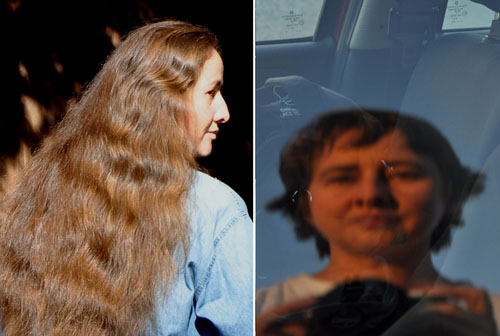
And since people still keep asking, one more explanation is in order. Yes, I did cut my long hair indeed exactly to facilitate the business of my fencing.
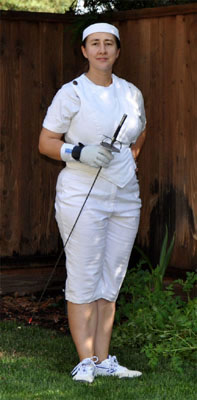
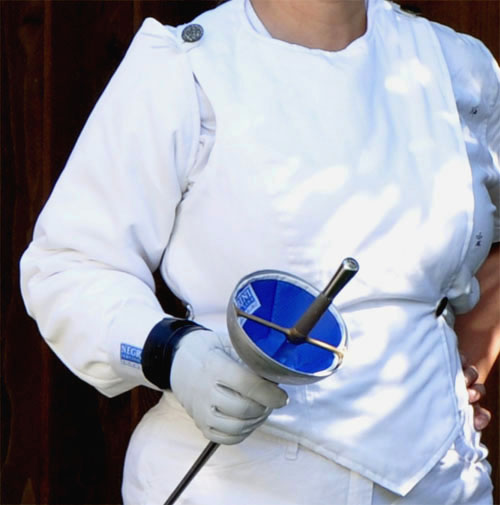
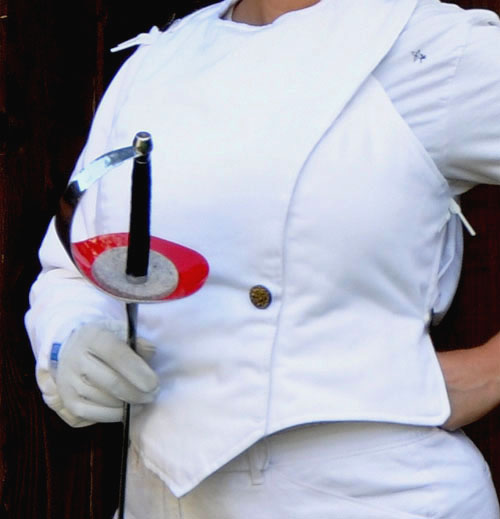
I also put my dress-making "do it yourself" skills to work, and below is the result--my new teaching "kit." The first photo shows my Summer Kit--Foil Configuration. The Epee Configuration includes also a sleeve, and the Sabre Configuration involves the addition of the "abdomen side" to the previous. Finally, there are also the more formal "Fencing Uniform" jacket and pants, of course (made for the occasion of my Provost Examination, as seen above).
|
And remember how I said at the beginning of this website that this whole story serves as a tribute to Maestro Sahm? He continued to come and give me lessons while I used to live at a San Jose house large enough to have a salle in it. Now that I moved to Stanford (as a Exchange Scholar at Stanford University), Maestro Sahm continues to give me lessons in conjunction with the San Mateo fencing classes. But it would not be Maestro Sahm if he did not add a special "bonus" on the top of everything. Since he concluded that while I have done "pretty much everything" already, but I have never experienced some serious aerobatics, he took me flying in his Christen Eagle II (experimental airplane). At first the weather had us guessing whether or not it will be nice enough for us to go up, and for me to do some serious picture-taking out there. But Maestro Sahm never gave up, even polishing the cockpit glass bright shiny for the most unobstructed picture-taking experience. Finally, the time came to "roll out."
And after the last weather check, Maestro Sahm called me to stop taking pictures from the ground and board up.
We took a last look back at the airport, and the fun began.
...then we "hopped" over the cloudy mountains...
..and headed for the sea...
After some more sight-fields and mountains-seeing, we headed back to san Jose.
Upon arrival back to the airport, it was time to gas up for the next trip.
And I have not even gotten anywhere close to breaking my good old rule concerning not inviting anyone anywhere without his wife. Quite the contrary. It was in fact Maestra Sahm who suggested to the Maestro already a few months before this actually happening that he takes me flying (the Maestra has already been, of course, although she was not interested in trying again :-).
|